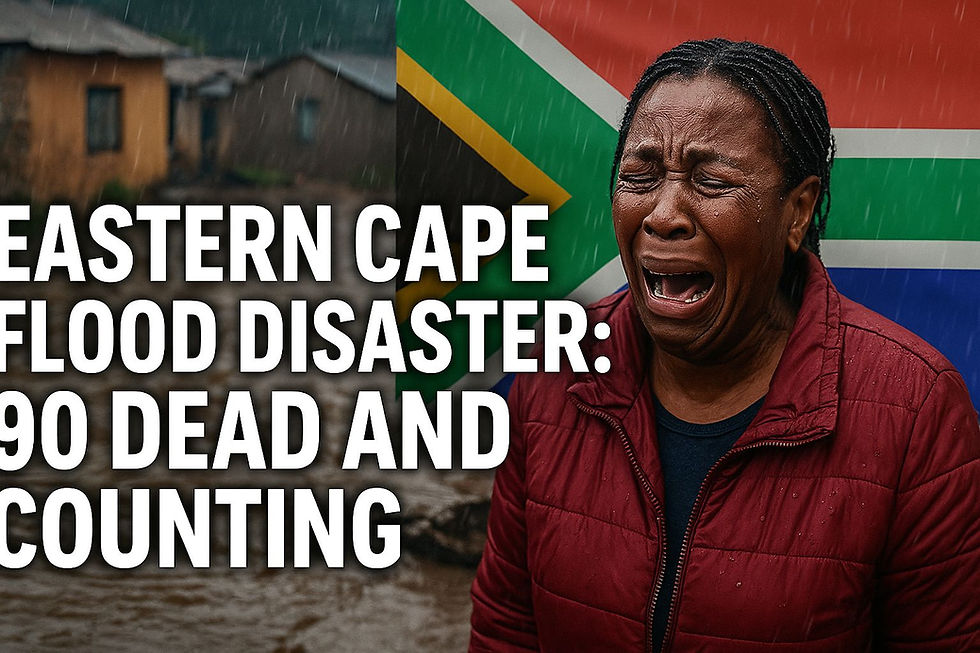Death Toll Rises to 90 in South Africa's Eastern Cape Floods
- Admin
- Jun 18, 2025
- 3 min read
By WorldWire News | June 18, 2025

South Africa’s Eastern Cape is reeling from one of its worst natural disasters in recent memory. Flash floods triggered by torrential rains have now claimed at least 90 lives, displaced thousands, and laid bare the fragile infrastructure and disaster preparedness gaps in one of the country’s poorest provinces.
A Week of Relentless Rain
The flooding began after several days of relentless downpours swept across key municipalities, including Port St. Johns, Mthatha, Buffalo City, and Nelson Mandela Bay. Rivers burst their banks, mudslides engulfed settlements, and hundreds of homes were swept away. According to the South African Weather Service, the region recorded some of the heaviest rainfall totals in over a decade.
What began as a seasonal weather pattern quickly escalated into a humanitarian catastrophe.
Areas Worst Affected
Port St. Johns: Dozens of homes flattened. Rescue teams report entire families missing.
Buffalo City: Key roads submerged, disrupting emergency response.
Mthatha & OR Tambo District: Collapse of bridges and sewer systems; hospitals overwhelmed.
Many of the deceased were children and elderly individuals trapped in informal housing structures or unable to escape the rising water levels. The search for missing persons continues, as emergency teams work through treacherous terrain.
Government Response Under Scrutiny
President Cyril Ramaphosa called the situation “a national tragedy” and has deployed the South African National Defence Force (SANDF) for evacuation and recovery efforts. However, criticism is mounting from civil society and opposition leaders who accuse the government of delayed action and poor disaster preparedness, especially in vulnerable rural and peri-urban communities.
The Department of Cooperative Governance declared the region a disaster zone, unlocking emergency funds for shelter, food, and reconstruction.
Still, for many, help arrived too late.
Voices from the Ground
“We heard the rumble at midnight. The water came so fast, we barely had time to grab our children,” said Nomsa Dlamini, a mother of four who lost her home in Lusikisiki.
“This is the third time in five years that our area has flooded. We get promises after every disaster. But nothing changes,” said Vusumzi Makeleni, a local teacher.
Climate Change and Urban Vulnerability
Experts have long warned that climate change is intensifying extreme weather events in Southern Africa. What was once a “100-year flood” now occurs every 5–10 years. Compounding this, unchecked urban expansion, poor drainage systems, and unregulated housing have made communities more susceptible to catastrophic loss.
Environmental researcher Dr. Zanele Khumalo remarked:
“Eastern Cape’s flooding isn’t just a weather story it’s a governance failure, an infrastructure crisis, and a climate emergency all rolled into one.”
Call for National and International Support
As shelters fill with displaced families and morgues struggle to cope, aid agencies are calling for urgent donations of blankets, water purification tablets, and medical supplies. Humanitarian organizations are working alongside government responders, but the scale of devastation has overwhelmed capacity.
Neighboring provinces and global partners, including the UN and Red Cross, have begun mobilizing support.
The Way Forward
While immediate rescue efforts are ongoing, the long-term challenge will be rebuilding with resilience. Eastern Cape’s disaster is a warning bell—not only for South Africa but for all developing nations grappling with the realities of climate change, inequality, and inadequate urban planning.
Key Stats at a Glance:
Death toll: 90 (and rising)
Missing persons: Dozens unaccounted for
Displaced: Estimated 3,000+
Homes destroyed: Over 1,200
Damage estimate: Exceeds R1.5 billion ($80 million)
Final Word
This tragedy must not fade with the news cycle. It should galvanize urgent action—not just in Eastern Cape but nationwide—to invest in climate adaptation, resilient housing, and early warning systems.
As one survivor said:
“We need more than sympathy. We need solutions.”









Comments